Will It Lens?
A couple weeks ago, Dustin got a whole bunch of people to each contribute a few dollars, and we bought a four foot by three foot fresnel lens. It arrived earlier this week, and we’ve been spending our lunch hours out in the sun playing with it.

Before I go too much further, I should explain what a fresnel (pronounced “freh-NELL”) lens is. A normal lens this big would be several feet think and weigh a proverbial ton. However, you can remove much of the inside of a lens and collapse down the shape without introducing too much distortion (just a little distortion):

The resulting shape is very thin, has lots of tiny ridges in it, and isn’t too much worse than a normal lens. Fresnel lenses are used in overhead projectors, lighthouses, and sometimes in the rearview window of schoolbusses so the driver can see what’s just below the back of the bus.
SAFETY NOTE: If you get one of these, do not store it in a sunny place! When you’re not around, the sun will shift and catch the lens just right and set something on fire. Our lens came in a cardboard sheath, to keep it out of the light when we’re not using it. We estimate that on a sunny day this lens can focus about a kilowatt of power onto whatever is at the focal point, which will heat things really hot really fast. So be very careful to keep your body out of there. On top of that, things in the focal point get very, very bright, particularly if they’re shiny. Looking at them is like looking at the sun, except moreso because it’s concentrated sunlight. So, watch your eyes in any way you can. We had a bunch of sunglasses and a couple pairs of welding goggles, but even the goggles weren’t enough. Several of us watched the proceedings via the reflection in the window, which helped a lot. So, squint a lot, and don’t look directly at what you’re doing for too long. Also, many things (particularly metals) can be very hot but still look room temperature. I burnt my hand on Wednesday by forgetting this; don’t make the same mistake I did (luckily I let go quickly, so it wasn’t a bad burn and I’m alright now). Also also, have a bunch of water and a fire extinguisher nearby, just in case. We haven’t needed the fire extinguisher yet, but the water has been quite useful putting out small fires before they get out of hand.
I’ve uploaded all the pictures, though I don’t intend to go through and tag them all with exactly what was going on. Here are some of the more interesting ones.
The main claim of the company from which we bought the lens was that you can melt pennies, so that was the first thing we tried.
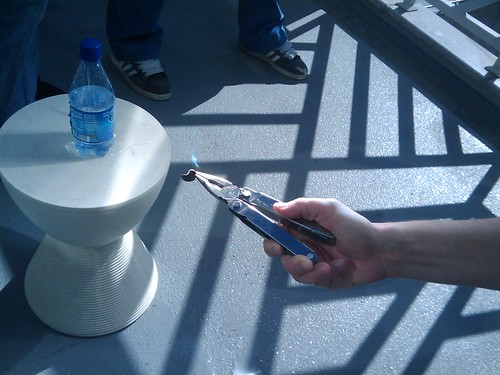
About 30 seconds later, success!

It turns out that pennies minted after 1982 are copper plated zinc, and zinc has a “low” melting point of a mere 693K. Copper, however, melts at 1356K, which means that the zinc would melt out while the copper was still solid, and the remaining copper was too thin to hold with the pliers and would fall out as well (incidentally, steel has a melting point over 1600K, so we soon came to trust the pliers to hold stuff without melting). We put a cup of water under the focal point so the molten zinc wouldn’t damage the balcony.

This resulted in copper shells and zinc slag. Here’s two pennies worth:
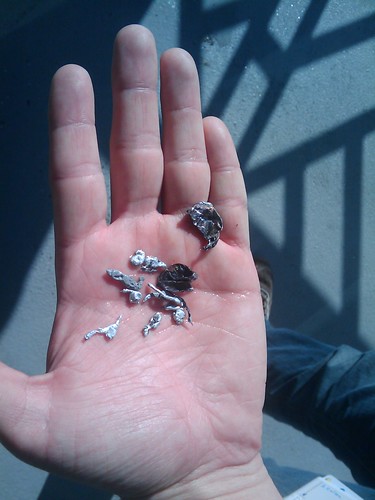
However, pennies minted before 1982 are 95% copper (interesting fact: they switched to zinc because these days a pennyweight of copper is worth enough that making a solid copper penny costs more than a cent). We tried lensing one of those (hoping that the pliers would hold solid copper better than copper plating, and we’d actually be able to melt it). This didn’t quite work; we got the penny pretty malleable, but it didn’t fully melt.

We’re not sure what that black crud on the outside is (a copper compound? Something from the oils on our fingers? Something pulled out of the air?), but when we dipped the penny in a cup of water to cool it down (with that crisp, satisfying snap), a bunch of the black stuff flaked off and settled to the bottom of the cup.
We tried a dime, which is an alloy of copper and nickel. At first it turned yellow.

We put it back in the light to try to get the other side to turn yellow as well, but then the whole thing turned black!

(aluminum foil holder used because we couldn’t find the pliers that day)
We have no idea why we got different results from heating the same dime twice.
Speaking of aluminum foil, we had high hopes that it would melt the first day because it melts at 933K, and if we could get copper to bend, surely aluminum was no problem. However, the aluminum is very shiny, and most of the light reflected right off it. It barely heated up, and it certainly didn’t melt. This turned out to be very useful, since we could use it to hold things and protect the floor (none of us had a crucible to actually put stuff in, and some of the experiments couldn’t be held with pliers).
So now that we could put stuff on the aluminum, we tried toothpaste. The top sizzled and crackled very loudly, and then turned into this white crusty stuff.
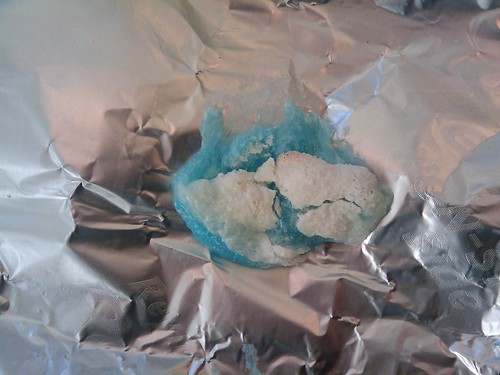
We suspect toothpaste has a lot of water in it, which boiled and caused the crackling as the water vapor escaped. but we have no idea why it turned white.
The candle melted into a pool of wax, but did not catch on fire. This surprised us somewhat, because paper catches on fire ridiculously easily. As in, you don’t even need it in the focal point; getting it in that general vicinity is enough to burst into flame.
We also tried Tylenol capsules, which released a white smoke that smelled terrible.

The remains were black and looked somewhat porous (though we couldn’t easily verify that).
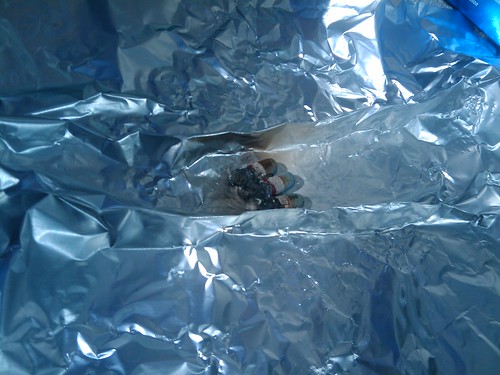
Milk made some gorgeous spectra, and steamed a little, but it didn’t do anything else (we had expected it to boil, or get that layer of film on top, or maybe even turn into pudding or something).

Half the group goes rock climbing, so we tried some rock climbing chalk next. Traditional chalk is anhydrous calcium sulfate (aka Plaster of Paris, aka burnt gypsum), but rock climbers, gymnasts, trapeze artists, and other people who use it to keep their hands dry long ago switched to using anhydrous magnesium carbonate, so that’s what we had on hand. I half hoped the magnesium would burn and release carbon, but there was no discernible change to the color or texture of the chalk.
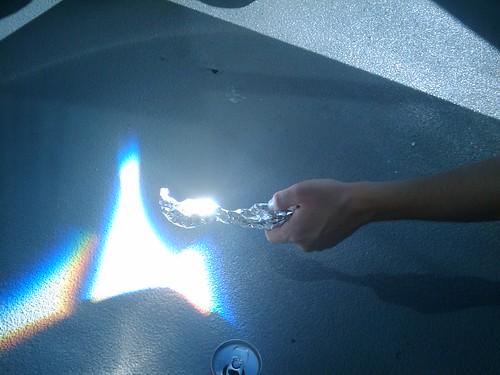
Edit: in hindsight, it’s obvious that nothing would happen. Magnesium carbonate is MgCO3, so the magnesium was already bound to oxygen, which is one of the most electronegative atoms I know of (second only to fluorine, and there probably wasn’t any of that around). So, the magnesium was already oxidized as much as it was likely to get, and even with heat we shouldn’t have expected anything to happen.
The lens company had also sent us a small, 8.5×11 inch fresnel lens, which was more than enough to burn an old gourd Dustin was about to throw out.
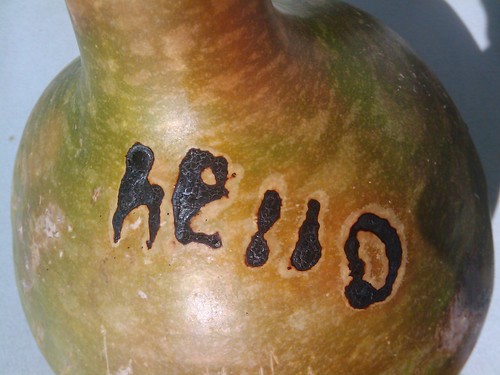
However, the big lens really did a number on this thing.
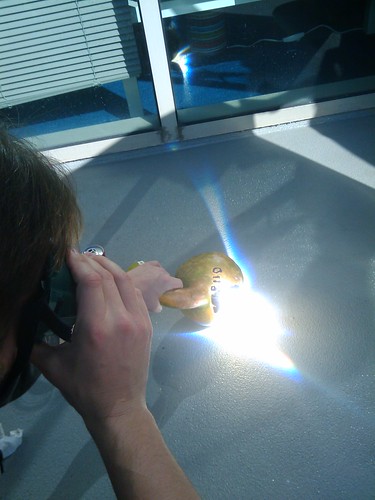
We found out that the reason it was so light was that it was hollow!
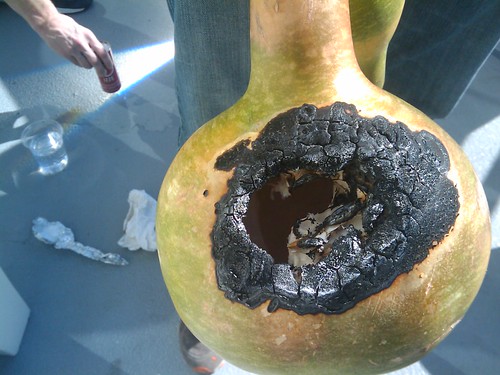
Although the aluminum foil reflected the light and didn’t get hot, we also had an aluminum can around. We had previously filled it with water and used it as a stand for some smaller things, but then we tried going after the can itself.

The water on the top of the can boiled almost instantly, and the water in the bottom steamed and really highlighted the spectra around the focal point. It was beautiful. However, the paint on the can evaporated away (have you ever watched steam evaporate off your mirror after a shower? It was like that). The aluminum itself seems to have binded with oxygen in the air, since it turned white and became very brittle. This was neat enough that we rotated the can several times and lensed the other parts of it, too.
It’s strange seeing the shadows of things near the focal point.
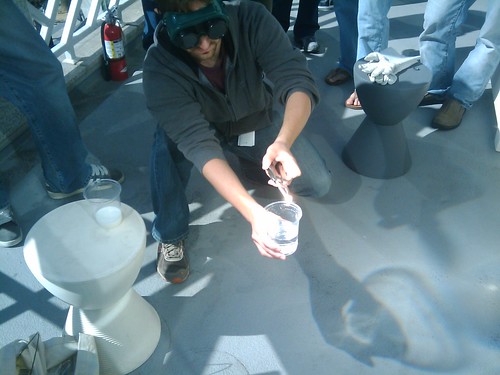
The lens, while clear, casts a shadow because it bends all the light towards the middle. and then things near the middle have their shadows twisted and elongated as though the light source is very close to them (think holding a flashlight under your face while telling a scary story). Stuff at the focal point itself has a blurry shadow because the fresnel lens has a bit of distortion in it and doesn’t have a really crisp focal point in the first place.
The next step is to build a wooden frame for the lens so it doesn’t keep bending and screwing up the optics. We’ve talked about making a whole death ray setup, but I’m not sure we want a concentrated beam that extends indefinitely, because we could accidentally catch something important in it while setting up or taking down the device. We’ll see what happens.
In the meantime, if you have interesting ideas of things to lens (preferably things I can acquire that aren’t too expensive and don’t require much safety equipment), I’d love to hear them!
Edit: check out part 2!
That makes me think of the Kindergarten Solar-powered Death Squad (about halfway down the page).
That’s pretty neat. I have to go to work, otherwise I’d spend some time thinking of suggestions.
As it is a heat source, you can try and initiate some chemical reactions that require a significant initial energy cost.
Thanks for the link! Bill Beatty has written a lot of cool things.
Neato!
If you can find a dime, nickel, or quarter from 1964 or before, it’s 90% silver, 10% copper. Much higher melting point.
I remember bars of Dove soap being fun to microwave. They might be fun to lens too.
The soap is an interesting idea! I’ll add it to our list of stuff to try.
As for old coins, I’m not sure we can melt silver precisely because it has a much higher melting point. On top of that, a silver dime has a melt value around 90 cents, so I’m fairly certain I can’t just pick up at the bank (all remaining ones should either have been melted down or put in coin collections years ago).
yeah
they are extremely rare, but i actually found a 1964 (last silver year) dime in change once, back when silver was farthur down at $4.50/oz or about half of what it is now.
Thanks for the soap idea; it totally worked! Check out part 4 or the entire photo set for the results.
You forgot the safety disclaimer about telling people *not* to put their hands into the light (like I do repeatedly). ;)
It’s the fourth sentence of the “SAFETY NOTE” paragraph. I can’t help it if you refuse to read the safety warning and ignore the rest of us when we plea with you to get your hand out of there (re: the cup of milk). I’ll just keep photographing. :-)
However, I and a bunch of other people would feel better if you had some sort of tongs or something to keep your hand farther away.
Think of my hand in the light as a train wreck. Yes, everyone would prefer that I not get burned, but it makes the experience so much more exciting to watch ;) .
I also wouldn’t do it if I believed that I would get burned; I’m not a masochist. I trust the lens carriers to keep it steady, and I trust my hand to be steady. Discussions about my sanity in trusting others with a lens that could burn my flesh instantly are still open.
I agree that in normal conditions, you won’t burn your hand. However, I’m concerned about unusual events. If there’s a medium-sized earthquake (like that 4.5 we had a couple months ago), your hand gets burned. If a bird craps on one of the people holding the lens and they get surprised, your hand gets burned. If something boils/pops/etc unexpectedly, your hand gets burned. That’s the sort of thing I’d like to avoid.
I appreciate your caution and concern, but I continue to be unworried.
Deleting your comment
Sorry, but I’m deleting your comment because it is completely off-topic and pushing a political agenda. I understand that you think the proposed bill would be terrible if passed into law, and lensing a copy of it might be entertaining. However, I intend to keep these posts as non-political as possible.
My removal of your comment should not be construed as an endorsement of the bill; I haven’t learned enough about it to form my own opinion.
Your other suggestion of an iPod is entertaining, but not within our budget.
things to lens
try piping the focal point through some fiber optics
focus the focal even further with small lens or magnifying glass
lens solar cooker try to make steak
things to lens
try piping the focal point through some fiber optics
focus the focal point even further with small lens or magnifying glass
lens solar cooker try to make steak